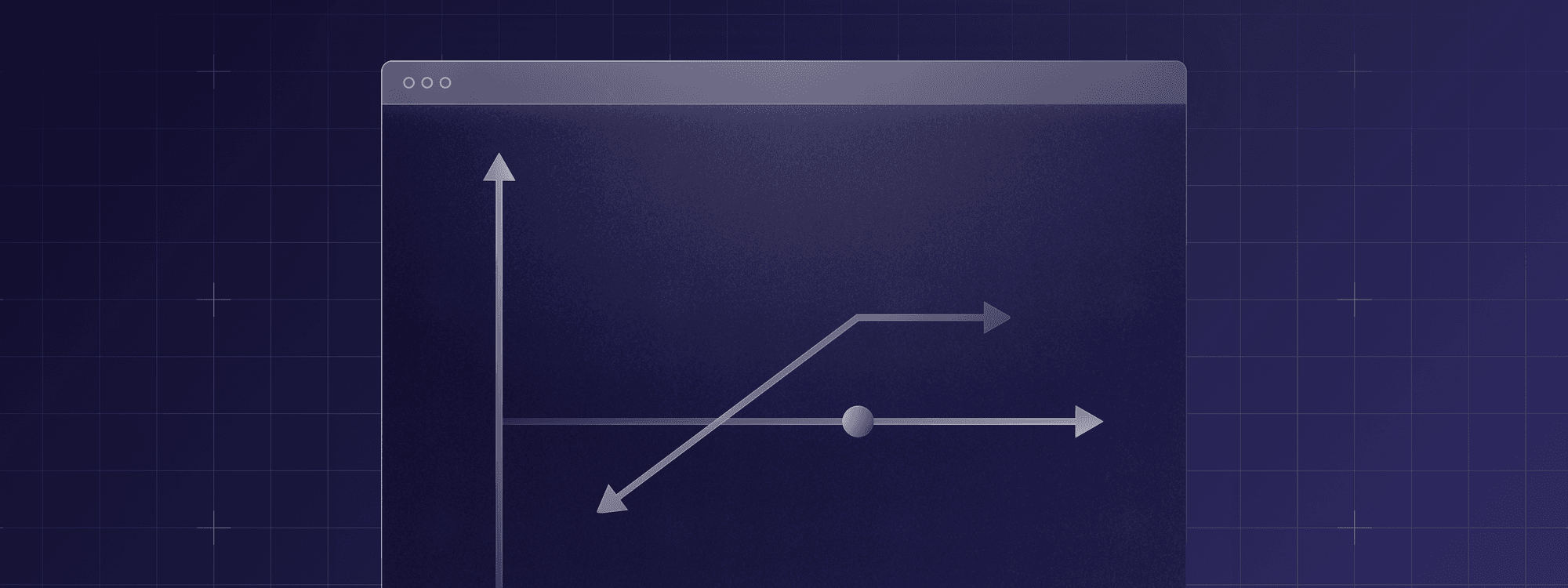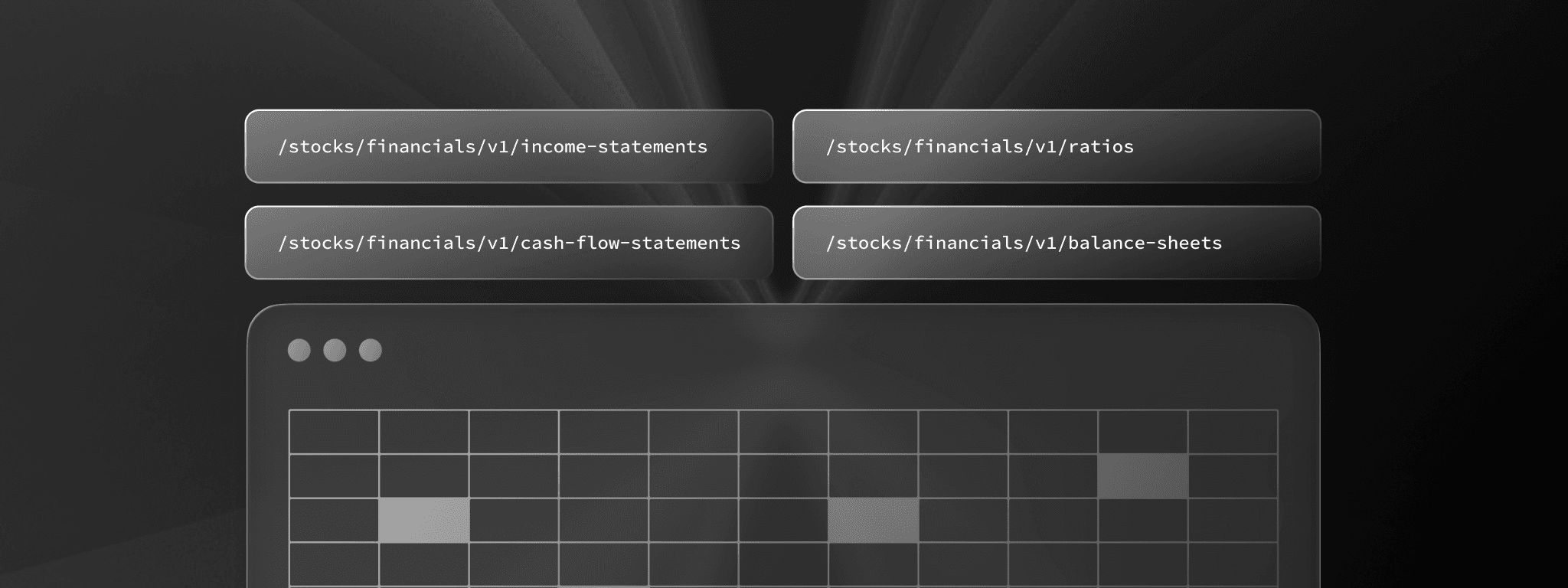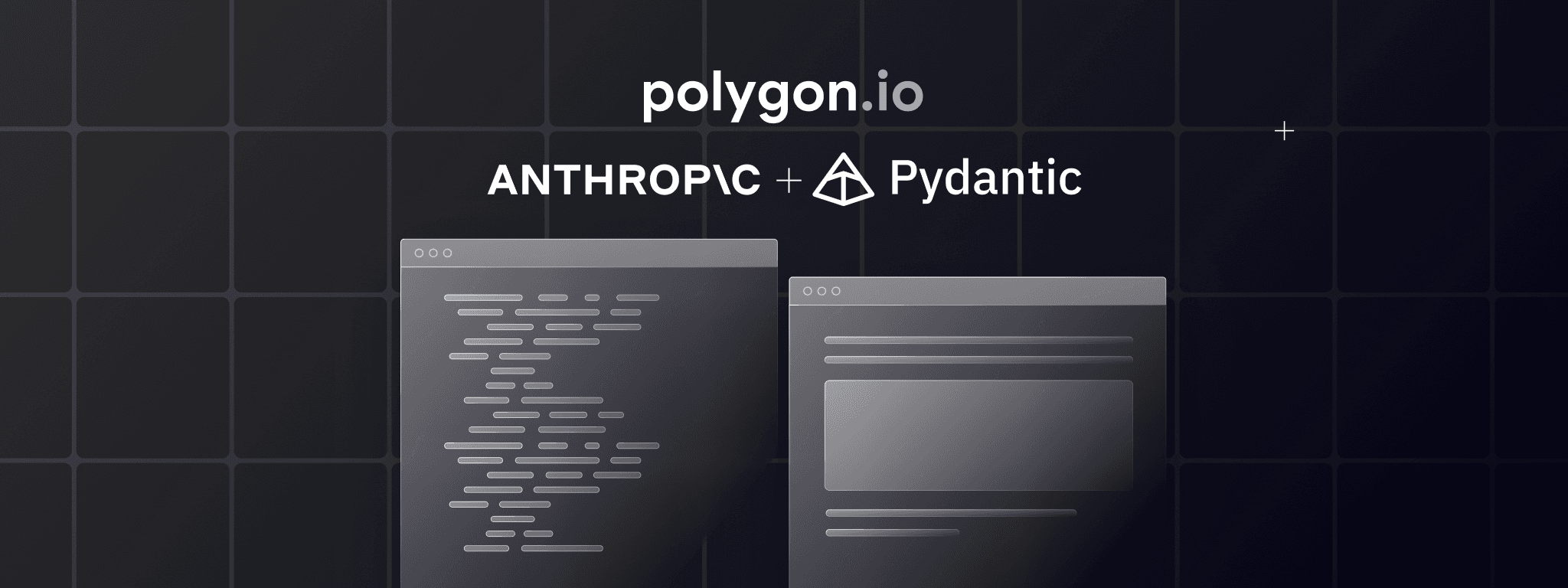
Polygon.io is Now Massive
Polygon.io is now Massive.com. The rebrand reflects our focus on scale, reliability, and continued innovation. Your APIs, accounts, and integrations continue to work without interruption.
editor

Introducing
Sep 30, 2025
In this demo, we’ll build a small Python utility that pulls only the option contracts you’d consider for a covered call expiring today (0-DTE) on SPY. Along the way, we’ll explain not just what to do, but why each step matters—especially if you’re new to options or market data.
Who this is for: developers comfortable with Python who want to automate an options workflow—even if you’re still learning options.
You must have an Massive Options Advanced plan for this demo to work properly.
You’ll also get an optional “mark” mode to take a previously saved CSV and compute realized P&L after the close.
You can find the full code for this demo in this GitHub repository.
A covered call means you own the stock (100 shares) and sell a call option on those shares. You collect premium up front—that’s income. If the stock finishes below your strike at expiration, you keep the premium and your shares (best case for income). If it finishes above your strike, you’ll likely be assigned and sell your shares at the strike; you still keep the premium, but your upside is capped. You’re still exposed to the stock’s downside, but the premium cushions smaller dips.
With 0-DTE options (expiring today), premiums can look small but time decay is fastest. That makes screening and timing important: small differences in quotes and spreads matter a lot, and simple safeguards help you avoid “ghost” quotes that aren’t really tradable.
We expose simple options so you can tune behavior from the command line:
Setting | Meaning | Good starting point |
symbol | Underlying ticker | SPY |
expiration_days | 0 for 0-DTE, 1 for tomorrow, 5 for days from today | 0 |
min_otm_pct | Lower OTM bound for calls (≥ spot) | 0.00 |
max_otm_pct | Upper OTM bound | 0.01–0.05 |
delta_lo/hi | Delta band for selection | 0.15–0.35 |
min_bid | Ignore tiny credits | 0.03–0.10 |
min_open_interest | Liquidity floor | 1–100 |
max_spread_to_mid | Skip quotes with too-wide spreads relative to mid | 0.75 |
rank_metric | Sorting metric (default premium_yield) | premium_yield |
outdir | Where to save CSV | ./data |
Before we touch market data, we need a logged-in client that’s safe to run locally and in automation (CI/CRON). Reading the API key from an environment variable keeps secrets out of your codebase and makes rotation painless.
import os from massive import RESTClient def make_client(): return RESTClient(api_key=os.getenv("POLYGON_API_KEY"))
“0-DTE” means “today” on the exchange calendar, not your laptop’s local time. If you run the script from a different timezone, you could accidentally pull the wrong day. We’ll standardize to America/New_York, compute today’s date, and estimate the remaining time to the close. That’s also useful later for rough probability estimates.
from datetime import datetime, time, timedelta from zoneinfo import ZoneInfo ET = ZoneInfo("America/New_York") def today_et() -> datetime: return datetime.now(ET) def target_expiration_date(days_ahead: int) -> str: d = today_et().date() + timedelta(days=days_ahead) return d.strftime("%Y-%m-%d") def minutes_to_close_on(date_str: str) -> float: d = datetime.strptime(date_str, "%Y-%m-%d").date() close_dt = datetime.combine(d, time(16, 0), tzinfo=ET) now = today_et() return max(0.0, (close_dt - now).total_seconds() / 60.0) def time_to_expiry_years(date_str: str) -> float: mins = minutes_to_close_on(date_str) return max(mins / (60 * 24 * 365), 1e-6) # keep small, never zero
A snapshot call returns what you need to screen in one pass: quotes (bid/ask), greeks (like delta), open interest, implied volatility, and the underlying’s price. That keeps the workflow fast and avoids stitching multiple endpoints. We’ll ask only for calls expiring today.
def fetch_chain_snapshot_calls(client, symbol: str, expiration_date: str): items = [] for o in client.list_snapshot_options_chain( symbol, params={ "contract_type": "call", "expiration_date.gte": expiration_date, "expiration_date.lte": expiration_date, }, ): items.append(o) return items
Almost every decision depends on spot: OTM boundaries, relative yield, breakeven, and max profit. The snapshot usually includes the underlying’s price; if not, we’ll fall back to a last trade lookup so the script remains robust.
def resolve_spot(chain, client, symbol: str) -> float | None: for o in chain: ua = getattr(o, "underlying_asset", None) if ua and getattr(ua, "price", None) is not None: return ua.price lt = client.get_last_trade(symbol) return getattr(lt, "price", None)
Here we translate strategy ideas into rules:
import math def norm_cdf(x: float) -> float: return 0.5 * (1.0 + math.erf(x / math.sqrt(2))) def midpoint(bid: float | None, ask: float | None) -> float | None: if bid is None or ask is None or bid <= 0 or ask <= 0 or ask < bid: return None return 0.5 * (bid + ask) def pop_estimate(S0: float, breakeven: float, iv: float | None, t_years: float) -> float | None: if iv is None or iv <= 0 or breakeven <= 0 or t_years <= 0: return None # Rough probability S_T >= breakeven near expiry (risk-neutral, r≈0) d2 = (math.log(S0 / breakeven) - 0.5 * (iv ** 2) * t_years) / (iv * math.sqrt(t_years)) return norm_cdf(d2) def screen_candidates(chain, spot: float, expiration_date: str, min_otm_pct=0.00, max_otm_pct=0.03, delta_lo=0.15, delta_hi=0.35, min_bid=0.05, min_oi=1, max_spread_to_mid=0.75, rank_metric="premium_yield"): lo = spot * (1 + min_otm_pct) hi = spot * (1 + max_otm_pct) if max_otm_pct else float("inf") t_years = time_to_expiry_years(expiration_date) rows = [] for o in chain: d = getattr(o, "details", None) q = getattr(o, "last_quote", None) g = getattr(o, "greeks", None) oi = getattr(o, "open_interest", 0) or 0 iv = getattr(o, "implied_volatility", None) if not d or not q: continue k = d.strike_price if k is None or not (k >= lo and k <= hi): continue bid, ask = q.bid, q.ask if bid is None or ask is None or bid < min_bid: continue m = midpoint(bid, ask) if m is None or m <= 0: continue spread = ask - bid if m > 0 and (spread / m) > max_spread_to_mid: continue delta_ok = True delta_val = None if g and getattr(g, "delta", None) is not None: delta_val = abs(g.delta) delta_ok = (delta_lo <= delta_val <= delta_hi) if not delta_ok: continue breakeven = spot - m max_profit = (k - spot) + m # if called away pop = pop_estimate(spot, breakeven, iv, t_years) rows.append({ "ticker": d.ticker, "expiration": d.expiration_date, "strike": k, "delta": delta_val, "bid": bid, "ask": ask, "mid": m, "open_interest": oi, "iv": iv, "spot": spot, "premium_yield": m / spot, "breakeven": breakeven, "max_profit": max_profit, "pop_est": pop, }) # Rank by your chosen metric if rank_metric == "premium_yield": rows.sort(key=lambda r: r["premium_yield"], reverse=True) elif rank_metric == "max_profit": rows.sort(key=lambda r: r["max_profit"], reverse=True) elif rank_metric == "pop_est": rows.sort(key=lambda r: (r["pop_est"] or 0), reverse=True) else: rows.sort(key=lambda r: r["premium_yield"], reverse=True) return rows
CSV works everywhere: spreadsheets, notebooks, dashboards, and batch research. Naming the file with the symbol and date makes it easy to build a historical dataset over time.
import pandas as pd from pathlib import Path def save_csv(rows, outdir: str, symbol: str, expiration_date: str) -> str: Path(outdir).mkdir(parents=True, exist_ok=True) df = pd.DataFrame(rows) path = Path(outdir) / f"{symbol.lower()}_{expiration_date}_0dte_calls.csv" df.to_csv(path, index=False) return str(path)
This turns your morning CSV into ground truth after the close. For each row, the covered-call result per share is:
def mark_realized_pnl(csv_path: str, underlying_close: float) -> str: df = pd.read_csv(csv_path) S_close = float(underlying_close) per_share = [] assigned = [] for _, r in df.iterrows(): K = float(r["strike"]) S0 = float(r["spot"]) c = float(r["mid"]) if S_close <= K: p = (S_close - S0) + c assigned.append(False) else: p = (K - S0) + c assigned.append(True) per_share.append(p) df["assigned"] = assigned df["pnl_per_share"] = per_share df["pnl_per_contract"] = df["pnl_per_share"] * 100.0 out = csv_path.replace(".csv", "_marked.csv") df.to_csv(out, index=False) return out ```
Low-friction, forward collection:
Historical reconstruction (deeper):
Formulas are handy, but it clicks when you see the numbers. Suppose your CSV shows:
Breakeven — the stock price where the trade neither wins nor loses at expiration:
That means if SPY finishes at $443.75, you break even. You’re cushioned by about $0.75 on the downside compared to owning the stock without the call.
Max profit per share — happens if you’re called away (SPY finishes above the strike):
You keep the premium and capture the move up to the strike, but nothing beyond it. Per contract, that’s $125 before fees.
Two end-of-day scenarios:
Rough probability of profit (POP): if implied volatility (iv) and time to close are known, we can estimate the chance that SPY finishes above breakeven (443.75). For same-day options, this is a quick, direction-agnostic sanity check. Treat it as a ranking helper—not a guarantee—because intraday behavior, spreads, and fills matter in the real world.
Again, you can find the full code for this demo in this GitHub repository.
import os, math, argparse import pandas as pd from datetime import datetime, time, timedelta from zoneinfo import ZoneInfo from pathlib import Path from massive import RESTClient from dotenv import load_dotenv ET = ZoneInfo("America/New_York") # Load environment variables from .env file load_dotenv() def make_client(): return RESTClient(api_key=os.getenv("POLYGON_API_KEY")) def today_et() -> datetime: return datetime.now(ET) def target_expiration_date(days_ahead: int) -> str: d = today_et().date() + timedelta(days=days_ahead) return d.strftime("%Y-%m-%d") def minutes_to_close_on(date_str: str) -> float: d = datetime.strptime(date_str, "%Y-%m-%d").date() close_dt = datetime.combine(d, time(16, 0), tzinfo=ET) now = today_et() return max(0.0, (close_dt - now).total_seconds() / 60.0) def time_to_expiry_years(date_str: str) -> float: mins = minutes_to_close_on(date_str) return max(mins / (60 * 24 * 365), 1e-6) def fetch_chain_snapshot_calls(client, symbol: str, expiration_date: str): items = [] for o in client.list_snapshot_options_chain( symbol, params={ "contract_type": "call", "expiration_date.gte": expiration_date, "expiration_date.lte": expiration_date, }, ): items.append(o) return items def resolve_spot(chain, client, symbol: str) -> float | None: for o in chain: ua = getattr(o, "underlying_asset", None) if ua and getattr(ua, "price", None) is not None: return ua.price lt = client.get_last_trade(symbol) return getattr(lt, "price", None) def norm_cdf(x: float) -> float: return 0.5 * (1.0 + math.erf(x / math.sqrt(2))) def midpoint(bid: float | None, ask: float | None) -> float | None: if bid is None or ask is None or bid <= 0 or ask <= 0 or ask < bid: return None return 0.5 * (bid + ask) def pop_estimate(S0: float, breakeven: float, iv: float | None, t_years: float) -> float | None: if iv is None or iv <= 0 or breakeven <= 0 or t_years <= 0: return None d2 = (math.log(S0 / breakeven) - 0.5 * (iv ** 2) * t_years) / (iv * math.sqrt(t_years)) return norm_cdf(d2) def screen_candidates(chain, spot: float, expiration_date: str, min_otm_pct=0.00, max_otm_pct=0.03, delta_lo=0.15, delta_hi=0.35, min_bid=0.05, min_oi=1, max_spread_to_mid=0.75, rank_metric="premium_yield"): lo = spot * (1 + min_otm_pct) hi = spot * (1 + max_otm_pct) if max_otm_pct else float("inf") t_years = time_to_expiry_years(expiration_date) rows = [] for o in chain: d = getattr(o, "details", None) q = getattr(o, "last_quote", None) g = getattr(o, "greeks", None) oi = getattr(o, "open_interest", 0) or 0 iv = getattr(o, "implied_volatility", None) if not d or not q: continue k = d.strike_price if k is None or not (k >= lo and k <= hi): continue bid, ask = q.bid, q.ask if bid is None or ask is None or bid < min_bid: continue m = midpoint(bid, ask) if m is None or m <= 0: continue spread = ask - bid if m > 0 and (spread / m) > max_spread_to_mid: continue delta_ok = True delta_val = None if g and getattr(g, "delta", None) is not None: delta_val = abs(g.delta) delta_ok = (delta_lo <= delta_val <= delta_hi) if not delta_ok: continue breakeven = spot - m max_profit = (k - spot) + m pop = pop_estimate(spot, breakeven, iv, t_years) rows.append({ "ticker": d.ticker, "expiration": d.expiration_date, "strike": k, "delta": delta_val, "bid": bid, "ask": ask, "mid": m, "open_interest": oi, "iv": iv, "spot": spot, "premium_yield": m / spot, "breakeven": breakeven, "max_profit": max_profit, "pop_est": pop, }) if rank_metric == "premium_yield": rows.sort(key=lambda r: r["premium_yield"], reverse=True) elif rank_metric == "max_profit": rows.sort(key=lambda r: r["max_profit"], reverse=True) elif rank_metric == "pop_est": rows.sort(key=lambda r: (r["pop_est"] or 0), reverse=True) else: rows.sort(key=lambda r: r["premium_yield"], reverse=True) return rows def save_csv(rows, outdir: str, symbol: str, expiration_date: str) -> str: Path(outdir).mkdir(parents=True, exist_ok=True) df = pd.DataFrame(rows) path = Path(outdir) / f"{symbol.lower()}_{expiration_date}_0dte_calls.csv" df.to_csv(path, index=False) return str(path) def mark_realized_pnl(csv_path: str, underlying_close: float) -> str: df = pd.read_csv(csv_path) S_close = float(underlying_close) per_share = [] assigned = [] for _, r in df.iterrows(): K = float(r["strike"]) S0 = float(r["spot"]) # Price when you sold the call c = float(r["mid"]) # Premium collected if S_close <= K: # Not assigned: keep the premium collected p = c assigned.append(False) else: # Assigned: premium + (strike - spot price when call was sold) # This represents the gain from selling at strike vs market price p = c + (K - S0) assigned.append(True) per_share.append(p) df["assigned"] = assigned df["pnl_per_share"] = per_share df["pnl_per_contract"] = df["pnl_per_share"] * 100.0 out = csv_path.replace(".csv", "_marked.csv") df.to_csv(out, index=False) return out def main(): ap = argparse.ArgumentParser(description="0-DTE covered-call screener") sub = ap.add_subparsers(dest="cmd", required=True) sc = sub.add_parser("screen", help="Run the screener and write a CSV") sc.add_argument("--symbol", default="SPY") sc.add_argument("--expiration-days", type=int, default=0) sc.add_argument("--min-otm-pct", type=float, default=0.00) sc.add_argument("--max-otm-pct", type=float, default=0.03) sc.add_argument("--delta-lo", type=float, default=0.15) sc.add_argument("--delta-hi", type=float, default=0.35) sc.add_argument("--min-bid", type=float, default=0.05) sc.add_argument("--min-open-interest", type=int, default=1) sc.add_argument("--max-spread-to-mid", type=float, default=0.75) sc.add_argument("--rank-metric", choices=["premium_yield", "max_profit", "pop_est"], default="premium_yield") sc.add_argument("--outdir", default="./data") mk = sub.add_parser("mark", help="Compute realized P&L for a prior CSV") mk.add_argument("--csv", required=True) mk.add_argument("--underlying-close", required=True, type=float) args = ap.parse_args() if args.cmd == "screen": client = make_client() exp = target_expiration_date(args.expiration_days) chain = fetch_chain_snapshot_calls(client, args.symbol, exp) if not chain: raise SystemExit("No contracts returned (holiday/closed market or filters too strict).") spot = resolve_spot(chain, client, args.symbol) if spot is None: raise SystemExit("Could not resolve underlying spot.") rows = screen_candidates( chain, spot, exp, min_otm_pct=args.min_otm_pct, max_otm_pct=args.max_otm_pct, delta_lo=args.delta_lo, delta_hi=args.delta_hi, min_bid=args.min_bid, min_oi=args.min_open_interest, max_spread_to_mid=args.max_spread_to_mid, rank_metric=args.rank_metric, ) if not rows: raise SystemExit("No candidates passed the filters.") path = save_csv(rows, args.outdir, args.symbol, exp) print(f"Wrote {len(rows)} rows to {path}") elif args.cmd == "mark": out = mark_realized_pnl(args.csv, args.underlying_close) print(f"Marked P&L written to {out}") if __name__ == "__main__": main()
Run examples:
# 0-DTE screen, default filters, save to ./data POLYGON_API_KEY=YOUR_KEY python screener.py screen # 0-DTE with a wider OTM band and tighter spread filter POLYGON_API_KEY=YOUR_KEY python screener.py screen --max-otm-pct 0.05 --max-spread-to-mid 0.5 # Mark yesterday's CSV with the official close python screener.py mark --csv ./data/spy_2025-08-29_0dte_calls.csv --underlying-close 444.83
In addition to this 0-DTE focused screener, I also wrote an advanced version that has more capabilities and automation. You can find the code for that screener here. Checkout the readme for more detailed instructions.
This content is for educational purposes only and is not financial advice. Options involve significant risk and are not suitable for all investors. Understand early assignment risk (especially near ex-dividend dates) and test thoroughly before trading real capital.

Alex Novotny
alexnovotny
See what's happening at massive.com

Polygon.io is now Massive.com. The rebrand reflects our focus on scale, reliability, and continued innovation. Your APIs, accounts, and integrations continue to work without interruption.
editor

There are four new fundamentals endpoints, one daily-refreshed ratios feed, and a developer experience designed for screens, research, and automated reporting.

alexnovotny

Learn how to use Massive.com's MCP server inside of a Pydantic AI agentic workflow, alongside Anthropic's Claude 4 and the Rich Python library.

alexnovotny